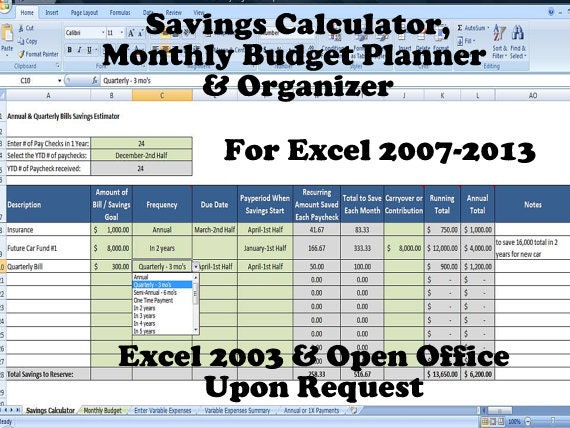
Use these tactics to guard against emergency expenses that might set you back. Offensive lines prepare for an unexpected rush on the passer by putting extra blockers in place and reading the defense. The consequences of a fumble are much higher in the “red zone,” so as you approach retirement you might consider moving your assets to lower-risk holdings, such as bonds and index funds. As you near your end zone, you might be limited to shorter-range plays. When a savings goal is on the distant horizon, you have more flexibility in how you save for it.įor instance, if you’re saving for retirement in your 20s or 30s, you might go for higher-risk investments, such as stocks and growth funds, which may get you ahead faster. With the ball on his team’s 20-yard line, a quarterback has the entire playbook at his disposal. Choose the Right Play for Your Field Position Staying light on your feet will let you take advantage of the openings when you see them.
SAVINGS PLANNER CALCULATOR FREE
This will allow you to periodically rebalance your investment portfolio to reflect changing risk environments and free up capital when new opportunities arise. Once you’ve made forward progress, look for ways to supplement retirement savings accounts with less-restrictive investment assets. Belt-tightening is one way to save money, but look for ways to increase earnings by working a second job, selling unused household items, or renting out a room or parking space. If your savings plan is too restrictive or rigid, you may lose steam and get frustrated when life doesn’t conform to your expectations. Teams that vary their pass and run game keep the defense guessing and give their players time to rest. When everyone knows the score and has a stake in the outcome, forgoing dinner out in order to stay on budget becomes a team effort. Kids who play a role in saving for college learn the importance of hard work and sacrifice. Spouses should manage their finances together in order to track and meet their savings goals as a team. You’ve seen the confusion on the field when a player misses a call.

Then draw up a budget that will let you save enough each month to reach your goal before the clock runs out. You can use our Savings Toward a Goal calculator to see how much you need to put away each month to reach your goal. Determine how much money you’ll need and how much time you have until you’ll need it. Because long-term financial goals can be hard to keep in perspective, a savings plan will let you focus on the present and call the right plays on the field. Set a Game PlanĪn offense doesn’t take the field without a strategy to get past the defense. Saving for a down payment on a house, your child’s education, or your retirement? Whether football season is right around the corner, or months away, these winning strategies will help you move the ball toward the end zone. Read more about state tax benefits for 529 plans, and estimate your state tax savings with our Tax 529 Calculator.Like a football team that drives 80 yards for a touchdown, reaching long-term financial goals requires planning and perseverance. Some states offer tax deductions for contributions to a 529 plan, which could further increase projected college savings if you invest your tax benefits.


Summary of using 529 plans for college expenses You can cover your college savings gap with student loans or other funding sources. To accurately predict your savings gap, the calculator accounts for your current savings, expected monthly contribution, and projected costs. This college savings 529 calculator gives you a realistic picture of your projected savings and potential funding shortfalls.


 0 kommentar(er)
0 kommentar(er)
